
Catalog excerpts

The new autoflex speed Increased Efficiency in MALDI-TOF MS Innovation with Integrity
Open the catalog to page 1
Accelerated Results with Increased Speed and Efficiency The autoflex™ speed series of MALDI based mass spectrometers has been designed to significantly increase productivity across a broad range of applications. With advances in performance and system capabilities, the autoflex speed series has the power, flexibility, and utility to be deployed in many analytical operations. Tissue Imaging Top-Down Protein Sequencing Polymer Analysis Glycan Analysis SPRi MALDI Interaction Analysis MALDI Biotyper Microorganism ID
Open the catalog to page 2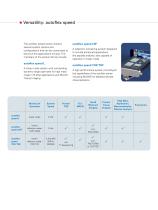
Versatility: autoflex speed The autoflex speed series contains several system options and configurations and can be customized to best suit the applications at hand. The members of the product family include: autoflex speed LRF A reflectron containing system designed to include enhanced applications like peptide analysis; also capable of operation in linear mode. autoflex speed TOF/TOF A linear mode system with outstanding dynamic range optimized for high mass range (>15 kDa) applications and MALDI Tissue Imaging. A high performance system providing all the capabilities of the autoflex...
Open the catalog to page 3
Harnessing the Power of Innovation The autoflex speed family of products encompasses numerous technology advances that provide researchers with: Unmatched analytical speed using smartbeam™-II, a 2 kilohertz laser and system electronics for intensive or high throughput applications. The MALDI customized smartbeam-II technology is exclusively developed, manufactured and maintained by Bruker for unsurpassed MALDI results. Expanded mass range capabilities to handle intact proteins and molecules such as large polymers. Superb broadband mass resolution and mass accuracy through proprietary PAN™...
Open the catalog to page 4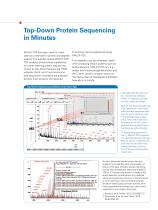
Top-Down Protein Sequencing MALDI-TOF has been used for many years as a standard in protein and peptide analysis The autoflex speed MALDI-TOF/ TOF systems extend these capabilities to further reaching protein sequencing known as Top-Down Sequencing (TDS), whereby the N- and C-terminal amino acid sequences of proteins are analyzed directly. Even proteins with blocked N-terminus can be sequenced using This capability can be extremely usefu when analyzing known proteins such as assign the N-term pyroglutamylation and the C-term Lysine truncation status of the heavy chain of therapeutic...
Open the catalog to page 5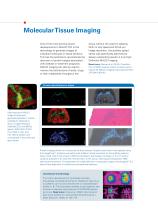
Molecular Tissue Imaging One of the most exciting recent developments in MALDI-TOF is the technology to generate images of individual molecules in tissue sections. This has the potential to revolutionize the discovery of protein targets associated with disease or treatment prognosis. MALDI imaging can also be used to monitor the distributions of lipids, drugs or their metabolites throughout the tissue without the need for labeling. With its kHz speed and 20-50 µm image resolution, the autoflex speed series was specifically optimized to deliver outstanding results in truly High Definition...
Open the catalog to page 6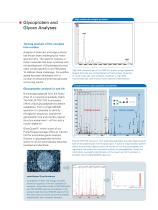
Glycoprotein and Glycan Analyses High molecular weight proteins Turning analysis of the complex into routine Analysis of polymers and large proteins has always been challenging for mass spectrometry. The need for analysis of these molecules has even increased with the development of Biotherapeutics that often contain glycans or are PEGylated. To address these challenges, the autoflex speed has been developed with a number of enhancements that generate convincing results. High MW measurement of the 350 kDa protein a-macroglobulin: Superb S/N ratio due to FlashDetector™ technology. Detection...
Open the catalog to page 7
Lipid Analysis and Microorganism Identification Bruker‘s unique TLC-MALDI solution hyphenates thin-layer chromatography (TLC) and MALDI-TOF MS extending the MALDI productivity to lipid profiling, herbals, cosmetics and food analysis. The MALDI Biotyper for identification and classification of microorganisms is a revolutionary approach to definitive identification and speciation of microorganisms. TLC plates can be coated in MALDI matrix within a few minutes permitting the molecular high resolution readout of entire TLC lanes. Molecular TLC-images or chromatograms are generated by dedicated...
Open the catalog to page 8
Polymer Analysis Applications in the field of synthetic polymers require equally good performance in both, small to medium mass range as well as high mass analysis. The autoflex speed series is well prepared for either of these tasks: Being equipped with the latest FlashDetector technology, the instrument provides outstanding resolution (R>26,000) and mass accuracy (≤ 2 ppm) in reflectron mode to address the complexity of e.g. Outstanding performance in high molecular weight measurement. complex co-polymer samples. Due to its real on-axis detector design, operating the system in linear mode...
Open the catalog to page 9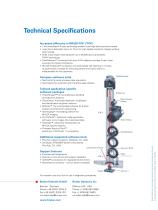
Technical Specifications Increased efficiency in MALDI-TOF (/TOF) 2 kHz smartbeam-II laser technology enables ultra-high data acquisition speed. Laser focus diameters down to 10 µm for high spatial resolution imaging without pixel overlap. Wide mass range resolving power up to 26,000 due to proprietary PAN™ technology. FlashDetector™ combined with new 4 GHz digitizer provides 2 ppm mass accuracy for highest confidence. MALDI Perpetual™ Ion Source with laser-based self-cleaning in minutes. Its push-button concept for removing sample and matrix debris is indispensable for kHz operation....
Open the catalog to page 10All Bruker Nano Surfaces catalogs and technical brochures
-
MultiMode 8-HR
8 Pages
-
Dimension Icon SSRM
2 Pages
-
AutoMet AFM Software
2 Pages
-
MBT STAR-BL Software
4 Pages
-
MALDI Biotyper CA System
8 Pages
-
PRIME
12 Pages
-
rapifleX MALDI Tissuetyper
8 Pages
-
MALDI PharmaPulse HTS
4 Pages
-
microflex
6 Pages
-
BioScope Resolve
8 Pages
-
AFM Dimension Edge
8 Pages
-
Dimension FastScan Bio
4 Pages
-
Dimension Icon
6 Pages
-
MultiMode 8 Brochure
8 Pages
-
Innova
8 Pages
-
Dimension FastScan
8 Pages

























